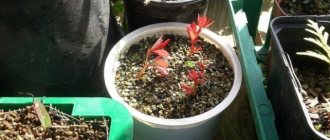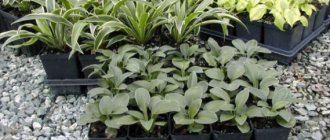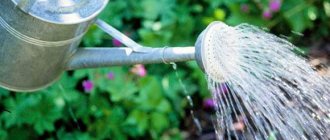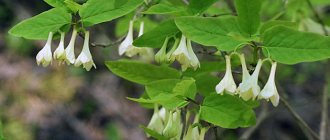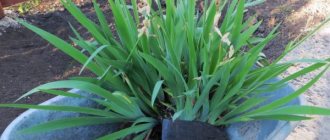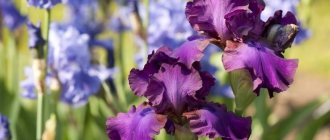Care
An unpretentious plant will not be very offended if the owners do not pay much attention to it. But a little care will help the flower produce fluffy buds and delight garden owners with large flowers.
As a maintenance procedure, periodic weeding and loosening of the soil will be useful.
Faded flowers are removed immediately after they die, protruding stems and wilted leaves are trimmed. But the second point is done rather to give an aesthetic appearance to the flowerbed.
And it is worth considering that the plant will move several centimeters in each direction every year. So very soon the problem will arise, where to put the children.
Landing rules
Irises can grow in one place for a long time, but as the rhizomes grow, they become bare and begin to “crowd” each other. Therefore, they have to be replanted regularly, every 3-4 years. Planting irises is a simple process that, knowing some subtleties, even amateur gardeners can cope with. The main thing is to try not to plant irises in even rows - they move and after a few years the “structure” will look sloppy.
When can you land?
You can plant irises in open ground throughout the entire summer season; they take root well in spring, summer and autumn. Most gardeners prefer to replant after flowering, when new roots begin to grow. Some leave it until late autumn.
The moment suitable for planting work is determined based on the climatic characteristics of the region. In areas with warm autumns and moderate winters, it occurs in September-October. In areas with frosty, harsh winters, it is better to postpone planting until spring. Irises take a long time to “take root” and do not bloom the next year after transplantation. Xyphiums are replanted in the first half of autumn.
Site selection and soil preparation
These flowers were considered perhaps the hardiest garden plants, but they were not distinguished by their beauty and variety of colors, and they quickly faded. Many gardeners continue to believe that it is enough to “stick it in the ground” somewhere and somehow. This is not the case with modern bright, graceful and long-flowering hybrids.
Choose a place for the iris that is sunny and at the same time protected from drafts. Most varieties tolerate light afternoon shade; Without the morning sun, they slow down, bloom less, and lose the rich color of their petals. It is better to plant irises in an elevated place where melt water will not collect in the spring - they have a negative attitude towards stagnant moisture. If this is not possible, the soil is drained at a depth of 20 cm and ditches are dug for outflow. The exceptions are varieties of Siberian selection and marsh irises, on the contrary, which prefer high soil moisture.
Regardless of the variety, irises require soil rich in microelements. A month before planting, the site is dug up using a shovel with well-rotted compost, ash and phosphorus-potassium fertilizers. If necessary, it is deoxidized with dolomite flour, chalk or lime; iris develops better in neutral or slightly acidic soils. Loams are enriched with lowland peat and sand. It is strictly not recommended to add manure to the soil for irises, even at the preparation stage.
Selection of planting material
The ideal iris rhizome for planting should be:
- elastic, dense;
- whole, without rot;
- do not have cord-like roots;
- with several links on one section;
- with tubercles - the rudiments of new roots.
For planting, select segments from three-year-old iris plants with a strong, not flaccid, without yellowing, leaf fan. The latter is cut to 15-20 cm. The requirements for iris bulbs are similar. They should be round in shape, elastic, without damage, rot, or lateral growths.
Before planting, healthy iris rhizomes are kept in a weak solution of potassium permanganate for 20 minutes. If rotten areas are still found, they are cut out; potassium permanganate is replaced with a solution of Fundazol. After drying, the sections are sprinkled with crushed charcoal. You can treat rhizomes with growth stimulants. The bulbs are prepared in the same way.
Planting irises in spring and autumn
When it is better to plant irises - in spring or autumn - gardeners decide based on the climatic characteristics of the region.
Regardless of the season, the process is carried out as follows:
- Shallow holes are dug in a previously prepared area.
- A layer of sand is placed on the bottom.
- The rhizome of bearded irises is positioned so that its upper part is above the ground level. Beardless and hybrids are buried several centimeters.
- Water generously.
When planted in depth, irises bloom little or even disappear. The distance between tall bushes should be about 50 cm, between medium-sized ones - 20 cm, and 15 cm between low-growing bushes. When planting iris in the fall, the protruding parts of the roots are mulched with peat - this will retain moisture, speed up rooting, and help the young grow safely through the first winter.
Planting irises in the spring gives them more time to take root; but at this time of year the roots do not grow very actively, so the young plants are regularly watered, avoiding overdrying or waterlogging. It is better to plant bulbous irises in the fall. The technology is the same. They are buried a few centimeters, watered, and mulched. In spring, the shelter is removed.
General description and varieties of irises
It happens that for some reason you need to store planting material for 2 weeks.
Do not store it in polyethylene or damp cloth. If you have a choice, take larger rhizomes, they contain more nutrients. If the division has 7 or more leaves, the flower will bloom the next year, in the spring. The best Before planting, the area is dug up using a shovel and all weeds are carefully removed, especially wheatgrass, edible grass, all types of thistle, etc. When preparing the soil, it is good to add rotted manure to a depth of 20-25 cm, without mixing it with the soil.
- “Iris” means “rainbow” in Greek
- You can also use pyrethrum - pollinate the plants with powder or leave 100-200 g of powder in 10 liters of water for 10 hours and spray with this solution.
- With the onset of the first frost, the foliage is cut in half, as when planting. When yellow leaves appear, cut them off. After flowering, the peduncle is broken off at the base. Before winter, when the first frosts occur, the plantings are covered with a 10 cm layer of peat; in the spring it must be raked.
- Some flower growers believe that irises can be propagated by leaves. This is also incorrect. An iris leaf separated from the rhizome, even under optimal conditions for root formation (in special greenhouses), does not form roots and gradually dies.
You also need to take care of the cuts. They are coated with a special mixture (sulfur and coal in a 1:1 ratio). Such a treated seedling will take root well and grow intensively.
Bulbous irises bloom for about two months: the first buds will appear in mid-May, and flowering will end at the end of June.
It is no coincidence that the strongest and thickest rhizomes are chosen for planting: they contain more nutrients, and the plant will calmly transfer to a new location.
Landing Features
To grow irises, it is enough to provide them with a well-lit place. Successful growth in both full sun and partial shade is possible. In summer, it is better for the plant to have dry soil than too wet.
Did you know? bearded iris
is
the state flower of Tennessee and the official plant of February.
autumn
Disembarkation time
The plant is planted in open ground with the onset of autumn (September). Plants take root better on warm September days and will produce beautiful spring blooms. In warm regions, planting can be delayed until mid-October.
It takes approximately 1.5 months to adapt and take root of the culture. If planted even later (in November), then the bulbous crop needs to be insulated for the winter. Otherwise, the bulbs simply will not have time to take root, and they may freeze in the winter cold.
There is useful information here on how to prepare the soil for planting irises.
Soil selection
Neutral acidity of the soil is quite suitable for irises; it is important that it is well drained. However, the ideal soil for the plant is limestone.
An alkaline reaction is achieved by adding chalk, lime and egg shells to the soil.
The soil, which is dominated by sand, is supplemented with humus. It is worth adding ash and superphosphate to such soil in the ratio: 40 g of fertilizer per 1 m². Coarse sand, humus and compost are added to clay soil.
Important! If the soil is too wet and does not dry out well, the irises will dry out.
How to plant
Agricultural technology for irises depends on the variety
However, it is important for each of them:
- avoid excessive soil moisture;
- fertilize with mineral fertilizers in a timely manner;
- have access to sunlight.
To prevent dampness, it is better to plant flowers on a southern slope. You can artificially raise the flower bed by 25–30 cm. This will ensure a good outflow of water after rain.
Before landing you should:
- dig and loosen the soil;
- enrich with organic fertilizers.
Did you know? Vincent Van Gogh, a famous Dutch artist, painted 2 paintings depicting irises. These paintings are highly appreciated in the modern art world.
Planting is done with a bulb. It is worth considering some nuances:
- large bulbs are placed in the soil to a depth of 7-8 cm;
- small specimens are deepened by 3-4 cm.
The interval between planting holes must be at least 10 cm for single plantings. For group - place 10 bulbs close to each other. After planting, the ground is watered for better rooting.
Methods for propagating irises
Irises can be propagated in different ways:
- dividing the rhizome;
- through seedlings.
It should be noted that almost all types of iris can be obtained by sowing seeds. However, bearded irises can cause problems. The fact is that their seeds have such a dense covering that they can lie without germinating for three years.
Seed material
There is one more subtlety that flower growers need to know. Iris seeds, as planting material, collected at home, do not always retain varietal characteristics. If different irises grow nearby, cross-pollination occurs between them. To preserve varietal qualities, plants are planted at a distance.
The seeds take a very long time to ripen, but the boxes can open instantly and their contents spill out. Therefore, the seed is tied with a piece of gauze. And in this form, the irises will remain until the seeds are completely ripened.
Seed method
The question of how to grow irises from seeds is far from idle. Moreover, not only beginning flower growers are interested, but also those who have experience. Iris seed material has its own characteristics: for germination they require stratification.
You can sow seeds:
When sowing in autumn, stratification occurs naturally. Under the influence of cold temperatures, green sprouts will appear on the beds as the weather warms up. Plants grown by winter sowing are more resilient and do not stretch. Seeds are sown in mid-September. For the winter, the bed is covered with 20 centimeters of soil.
If it was decided to grow iris, for example, Siberian, by sowing seeds in the spring, then it is necessary to carry out artificial stratification. Place the seeds in a container, wrapping them in a damp cloth. The seed should be kept under the freezer for a month. The fabric should always be damp.
In February or March, the seeds are sown in loose soil in separate cups. Planting depth is no more than 2 cm. Irises need to be grown in good light and warmth.
Planting root irises: propagation by rhizome
Vegetative propagation is used most often, since it is much less labor-intensive than growing from seeds, and it allows you to achieve the desired result faster. The very next year after transplantation, the plant will begin to bloom. The cuttings used are the so-called one-year-old rhizomes from which the lower leaves are cut. The cuttings are collected after the summer flowering period ends - usually the beginning of July. This is the best time for plant propagation.
- It is necessary to dig it up once every 3-5 years, since in unkempt areas the plant will quickly begin to form a dense carpet.
- The flowers will become smaller.
- The dug up rhizome is freed from dry and diseased leaves, in addition, you need to carefully examine the root.
- If it has partially begun to rot, all affected areas must be removed as soon as possible.
- In this case, the cut site must be covered with a mixture of sulfur and crushed coal - this will protect the root from further spread of the disease.
Parts of the rhizome in the garden bed are placed at a distance of approximately 40 cm from each other, so that it has . The earth is dug up to a bayonet depth, after which the rhizomes can be placed in the garden bed. Planting material is placed only vertically, while the bud should remain at surface level. Do not plant the plant too deep; all remaining leaves should be completely on the surface and located vertically.
How to propagate irises by seed
The flowering period of different types of irises in mid-latitudes: from April to July. Flowering time is usually 10–14 days.
As soon as the iris has faded, a gauze bag should be carefully placed on the ripening seed pod and secured to the stem. If a ripe capsule suddenly cracks, the seeds will remain in the bag
To collect seeds, you should leave some of the boxes and cut off the rest.
The harvested planting material is used in the fall or next year in the spring. There is no point in storing seeds longer; they lose their viability.
Seeds should be collected only from healthy, mature bushes
Seed methods for planting irises:
Method 1:
- In September, ripened seeds are planted directly in the flowerbed. The seed planting depth is 2 cm, the distance between holes is 10 cm, between rows is 25 cm.
- When planting in autumn, the soil should not be too soggy. Seeds are planted “dry”, without watering.
- To prevent the sprouts from freezing, the flower bed with the planting should be covered with fallen leaves or spunbond.
- You can plant seeds in the spring in the same way. The only difference is that the spring planting procedure necessarily includes watering according to the standard scheme: warm, settled water from a garden watering can with small holes, so as not to accidentally wash out the shallowly planted seeds.
Method 2 (seedlings):
- Before planting, the seeds should be pre-stratified - wrapped in a damp cloth, placed in a closed container and placed in the refrigerator on the top shelf for a month.
- After this, plant in nutritious soil for seedlings.
- The time for planting seeds is February.
- The time for planting seedlings in the flowerbed is May.
Propagating irises by sowing seeds has several disadvantages:
- Varietal irises propagated by seed do not necessarily inherit the characteristics and distinctive characteristics of the variety. Much more often, hybrids emerge from seeds, with some varietal characteristics lost and new ones appearing.
- An iris grown from seeds will bloom no earlier than in 2-3 years, while irises planted by division, in favorable conditions, can bloom as early as the next year and even the same year if the flower was grown from a plot on the terminal buds and planted in open ground in early spring.
How to plant by dividing a bush?
It is easier to propagate the crop using the vegetative method, and this way you can achieve flowering the very next year. To prevent degeneration of mature plants aged 4–5 years and maintain their ability to bloom, it is advisable to divide irises every 3 years. There are certain periods during the season for this.
You can plant flowers in spring and summer, when the petals have already fallen, but it is also possible to do this in early autumn, while the days are warm. Transplantation in all cases has some differences, which should be known to those who have not previously propagated this crop. Gardeners with sufficient experience in growing and propagating irises are advised to orient the roots of the plant to the south when planting: this will promote optimal heating by the sun's rays and the formation of a large number of young buds.
in spring
First of all, disinfect the knife with a solution of potassium manganese, and then divide the rhizome into parts. For this purpose, underground shoots are taken at the age of 1–2 years. They should have buds and several leaves: 5 or 7 pieces. Disinfection of the instrument is also carried out during division, and after completion of the procedure, crushed charcoal should be applied to the cut sites or lubricated with potassium permanganate.
Seedlings left in the fall are treated with compounds that stimulate plant growth. This is necessary to accelerate root development
If the root shoots are excessively long, they are carefully trimmed and rotten parts must be removed. Planting is carried out as follows:
- make a small hole and pour cleaned sand into it;
- the rhizome with the tops of the leaves cut off is placed horizontally in the hole;
- the soil is sprinkled so that the top of the roots remains outside;
- the next plant is placed 50 cm from the one already planted;
- After planting, the land is irrigated abundantly.
In summer
The ideal time for seeding and planting is mid-summer. As a rule, the hottest days are observed in July. When the soil is very hot, crop growth stops, some plants shed their leaves, and the development of the root system and lateral shoots is inhibited. The irises should bloom, and after that they can be divided.
- Dig up the plants using a pitchfork so as not to damage the roots. Then separate parts of the rhizome with a knife or clean hands. Many gardeners prefer to simply break the rhizome: this way the planting material is less damaged.
- Young roots are soaked in a solution of potassium permanganate for about 2 hours, and then dried for at least 4 hours.
- Before planting the plants, it is advisable to allow the cuttings to heal; this takes about 6–7 days. After this, the root shoots should be shortened, leaving a length of 10 cm. The tops of the leaves are cut off, leaving 10–14 cm.
- Annual links can be divided into 6–8 parts, the main thing is that each of them contains a bud, which, when planting, should be in line with the soil surface. More cuttings are formed from the lateral buds.
in autumn
Some varieties of irises are best divided and replanted in early September, when the plant resumes growth and other vital processes. This is especially true if the summer was rainy and not too hot. Irises planted in early autumn have time to gain strength and develop a root system before the upcoming frosts, and then successfully overwinter. After planting the plants in the soil, water it well.
After the water has been absorbed, the soil must be loosened and sprinkled with mulch.
Not everyone knows, but you can also propagate irises by sprouts. During flowering, you need to cut off the sprout from the mother plant, grabbing a piece of the rhizome. Young sprouts are planted in a cool place, in the shade, and are constantly sprayed. Rooting occurs very quickly: literally in 2 weeks. At the same time, you don’t have to worry about the fact that varietal characteristics will not appear.
Planting material
The standard planting unit of bearded iris is an annual unit - a “scapula” with a fan of leaves. The number of leaves can usually be used to predict whether flowering will occur next year. If the fan consists of 7-8 leaves, the flower bud should already have formed, and if it consists of 3-4 leaves, you will have to wait 2-3 years for flowering.
If the time has come to divide the irises in the garden, then the bush must first be watered, dug up with a pitchfork from all sides and removed from the ground. After washing, the rhizomes are cut into segments with one or two annual links. First, they are disinfected in a solution of the Maxim drug, then lightly dried in the sun. Leaves and roots are shortened to reduce moisture consumption, leaving only 10 cm. Such divisions can withstand dry storage at room temperature for 2 weeks without any damage. Wet storage is contraindicated, as the rhizomes may rot. The links remaining after division without roots and leaves are also used - they are planted in a school for growing. The next season, dormant buds awaken on them, but such plants bloom later, sometimes by 5-6 years.
How to grow irises from seeds?
Varietal irises are propagated by seeds. However, the preservation of parental species characteristics is not guaranteed. This is due to the fact that the varieties are obtained by hybridization using different species and, in addition, the flowers can be cross-pollinated by other varieties of irises growing nearby.
Selection and preparation of planting material
Mature iris seeds are large and light brown. They are formed in fruits - three-locular boxes. The fruit is formed after the irises fade. It takes 2-2.5 months for the seeds to ripen. On those bushes that they decided to propagate by seeds, the baskets are left, all the rest are cut off.
When the seeds ripen, the fruit splits. Gardeners put small gauze (tulle) bags on the boxes to prevent the seeds from spilling onto the ground. Dry boxes need to be cut, broken, and the seeds poured into prepared bags. Store in a dark, cool and dry place.
Growing time
Autumn planting takes the least time. Only seeds from the current year are used; last year's seeds are not suitable because germination is low. In autumn you can sow at any time. In those regions where there is weak snow cover, the ridge needs to be covered with leaves, straw or covering material for the winter.
In spring, iris seeds are planted in the ground when the soil warms up to 10-15 °C. Before this they are stratified. You can grow seedlings at home. In this case, stratified iris seeds should be sown in February, and with the onset of warm May days, the seedlings should be transplanted into the garden.
Selection and preparation of a landing site
The flower culture prefers neutral and slightly alkaline soils, loves light, but can grow in light partial shade. Preference should be given to elevated places protected from the wind. Garden soil free of weeds is suitable for irises. When digging, add:
- clay, peat, humus into sandy soil;
- dolomite flour into peat soil;
- river sand, peat, humus into clay soil.
Sowing seedlings
In autumn, the seeds are sown dry. The soil is not watered after planting. The seeds are buried 2 cm. They are planted in rows located at a distance of 25 cm from each other. The planting step is 10 cm. The bed is covered with 2 layers of lutrasil for the winter. When planting in spring, the soil is watered and the seeds are placed in furrows when it settles.
Further care
In spring, shoots appear. Caring for them is easy. It is necessary to regularly remove weeds and loosen the soil shallowly. Pulled weeds can be left between rows. They will protect the soil from drying out. You need to water the seedlings in the morning before 11 o'clock. Water should not get on the leaves. Before transplanting to a permanent location, seedlings can be fed with complex fertilizer “Kemira Lux” or “Kemira Universal”. To prevent pests, sprinkle the soil with sifted ash after watering.
Transplantation to a permanent place
A week before transplanting irises, prepare the area. The soil is dug up to a depth of 25-30 cm, for each square meter of ridge add 8-10 kg of humus, 2 tbsp. l. superphosphate, 2 tbsp. ash. If the acidity is high, add dolomite flour.
You can plant seedlings in a permanent place after the appearance of the 3rd leaf. The bushes are dug up with a clod of earth and planted in prepared holes. Planting schemes used:
- step 60 cm for tall varieties;
- 40 cm for medium-sized children in mixborders;
- 25 cm for dwarf irises.
Nuances of plant care in open ground
Care for adult specimens is minimal. Hobbyists grow 100 of them in their gardens. With the right choice of location and planting, the perennial blooms profusely and annually.
Watering and fertilizers
In the absence of rain, moisten once a week. Swamp varieties like abundant and more frequent watering. They can grow in water. Organic matter in the form of fresh manure cannot be used as fertilizer. For a perennial, 3 fertilizings with any complex fertilizer for flowering plants are enough per season.
Trimming
Flowering begins in spring. With a large number of varieties, it continues until mid-summer. They maintain the decorative appearance of the flower garden by trimming faded flower stalks. They are cut at the level of the leaves. Yellow leaves are cut near the ground.
Preparing for winter
The leaves are cut at a height of 15 cm from the ground, creating a fan of leaves. The soil is sprinkled with ash and covered with leaves or spruce branches. Organic mulch is a good replacement for any purchased covering material.
Reviews
SAVA, Dankov, Lipetsk region.
A few notes on agricultural technology for irises. Irises love to expose their backs to the morning sun, so choose your planting site with this in mind. Irises are ascetics and it is better to underfeed them than to overfeed them. In August, sprinkle the rhizomes with ash, good for diseases and better wintering. For wintering, cover the rhizomes with soil and remove this soil in the spring. Irises grow quickly; when you see that the rhizomes begin to creep on top of each other, divide. Do not buy a flowering fan, after flowering this fan disappears, make sure that you buy a flowering plant with a large enough piece of rhizome so that the dormant buds wake up later and you do not throw money down the drain. The optimal time for reproduction in irises is 2 weeks after flowering, when rhizomes and new roots begin to grow.
Irises love neutral and alkaline soils. They are transplanted immediately after flowering, from the end of June to the beginning of August, onto a raised bed or mound. When planting, the bush is divided into sections, the roots are shortened, the leaves are cut by 2/3, a mound is poured into the hole, the roots are straightened, the heel should be on top. Irises love a dry, sunny location. To lay flower buds, in August the leaves are cut by 2/3, and withered flower stalks are regularly removed.
Step-by-step instructions for summer planting irises with photographs
When planning to plant irises in the summer, you should take care in advance to prepare the bed for them. It is necessary to choose a sunny place protected from the wind: damp lowland areas with shading will destroy the flower. If there are concerns that the soil is not drained enough, you can raise the flowerbed by 20 cm or make it with a slope to the south, and also dig grooves to drain rainwater
However, Siberian irises require more shade and moisture than others: pay attention to the characteristics of the varieties provided by the breeder
Table: ways to optimize soil acidity for planting irises
When the flowerbed is ready, we begin planting irises in a new place, adhering to the following algorithm:
We choose an overgrown bush to be divided: the recommended frequency of replanting irises is 3–4 years. It's time to divide this iris
Using a garden fork or shovel, carefully dig up the bush and prepare divisions: each should have at least one annual growth with roots extending from it and a beautiful fan of leaves. A correctly separated iris seedling looks like this
Having divided the rhizomes, cut off the flower stalks and shorten the leaves by two-thirds. To protect the seedling from wind and excess moisture evaporation, leave only a third of the length of the leaves
We also inspect the roots, removing rotten ones and shortening the total length to 5–6 cm. Leave the length of the iris roots to 5–6 cm
Soak the divisions for 20–30 minutes in a pink solution of potassium permanganate (0.2%). For the purpose of disinfection, you can also sprinkle fresh cuts with crushed charcoal. Powdered coal is indispensable when you need to sprinkle root sections of plants
We leave the blanks to dry in the sun for a couple of hours so that the cuts are tightened and are less susceptible to fungi and bacteria. Dried sections are more protected from diseases than fresh ones
At the planting site, we dig shallow holes, fill part of the soil back in the form of a mound, on which we place the seedling
Sprinkle it, carefully straightening the roots. Planting pattern: at a distance of 30–50 cm in a checkerboard pattern. Carefully place the roots of the iris on an earthen mound
Important! The base of the rhizome remains above the ground, otherwise the iris will quickly rot!
We never bury an iris seedling, otherwise it will rot.
We water the plantings with warm water; in dry weather, repeat watering at least once a week. The soil must be moistened to a depth of at least 10 cm; one seedling can require up to 5 liters of water. To prevent the superficial root system from being exposed, it is recommended to use a watering can with a fine mesh, and also to carefully loosen the soil under the plant after watering. Without moistening the soil, iris will not take root in a new place.
An established iris will retain green leaves until autumn, and with the onset of cold weather they will wither.
Weakened or disease-affected divisions may not germinate after wintering, but this rarely happens - the iris is quite tenacious. In the spring, the strongest seedlings will already bloom; small ones will take another year to grow and lay flower buds.
Land preparation
Preparation for planting begins with choosing a sunny area. Iris need at least 6 hours of bright sun per day. Once selected, dig up the area to a depth of at least 15 cm. Or form raised beds to the same height if the area is too clayey.
Apply organic fertilizer if necessary. It can be compost or humus. Iris prefers well-drained garden soil. When planting, use a fertilizer that is low in nitrogen and high in phosphorus. For example, 5-10-10, where the numbers indicate the percentage of nitrogen, phosphorus and potassium in the solution. Apply it at the rate of 150 g per 5 m² area. Mix fertilizer into the soil immediately before planting.
Requirements for growing root irises
Root and bulbous irises differ in their requirements for growing conditions:
- Bulbous varieties love warmth and sunlight more; it is more difficult for them to create an ideal environment for long flowering.
- Root irises are less whimsical, and it is much easier for them to find a place on the site.
This type of plant has the following requirements for the location and growing conditions:
- The soil should not be too dense. In order for irises to grow well, you must add peat and sand to the soil, and mix the mixture thoroughly with a shovel.
- In acidic soils, irises produce leaves, but in this case they will not bloom.
- In this case, it is necessary to introduce ash into the ground or otherwise neutralize excess acidity.
- It is advisable to provide a drainage layer in the soil, since a common disease of irises is root rot.
- At the same time, the iris is, so it will have to be watered often. The soil should always be slightly moist.
- Root iris is a light-loving plant, but it does not like extreme heat. In the southern regions with a warm climate, it can be grown in the shade, while it will feel great and produce large flowers at the right time.
- Excess sun, on the contrary, can damage the leaves and cause petals to fall off.
- Fertilizers will need to be added to the soil about a week before planting. The main type is nitrogen fertilizers, which must be applied to depleted soil. At the same time, the amount of fertilizing should not be excessive.
Special requirements apply to planting material. If you have taken a young rooted or bulbous plant, they should not be wrapped in polyethylene or a wet cloth before planting. The roots begin to rot very quickly, so they should simply be stored loosely until planting.
What type of iris to choose for the site
Since there are many types of irises, many novice gardeners are lost and do not know what is best to choose. If you are not satisfied with the usual bearded iris with blue flowers, you can decorate your garden with the following exotic species:
- Yellow Queen is a variety of bulbous iris, which is classified as iridescent due to its special color. The main tone of the bud is yellow, but it differs significantly on the lower and upper petals.
- Iridodictium Vinogradova is an interesting bulbous variety, with white petals covered with an interesting dotted pattern. It will look unusual in the garden, and at the same time it is not particularly demanding to care for.
- Juno Bukhara is a plant with narrow petals and two-color white and yellow buds. This plant looks amazingly elegant; it is one of the most fragile and exotic varieties.
These are just some of the unusual types of irises that you can plant. It is not difficult to create for iris; they can grow even with moderate watering.
More information can be found in the video.
All varieties of irises are and are capable of growing in one place for more than 20 years. However, over time, the bushes grow greatly and begin to take up a lot of space, “absorbing” the space around them with a diameter of up to 2.5 m. In addition, dense plantings adversely affect the flowering of irises, reducing its quantity and quality. To prevent this situation, old irises should be divided periodically.
Planting irises
When and where to plant irises
It is generally accepted that irises should be divided and replanted immediately after flowering to give them time to set before winter. But if autumn is warm and long in your area, you don’t have to rush into replanting. In fact, irises can be planted in spring, autumn, and summer after flowering. The main thing is not to forget to replant irises every 3-4 years, and Siberian irises - at least once every ten years, otherwise they degenerate, grow and stop blooming.
In the photo: Growing irises in a flower bed
Bearded irises should be planted on well-lit slopes or hills in the first half of the day, protected from drafts, so that there is an outflow of melt water and good drainage. Swamp and Siberian irises, on the contrary, love moist soil. But both irises love rich soil, and if the soil on your site does not meet this requirement, add rich garden soil or compost to the soil in the spring before planting, and fertilize it with potassium-phosphorus fertilizers. If the soil is acidic, add dolomite flour, chalk or wood ash. If the area is loamy, add peat and sand; if, on the contrary, the area is sandy, add clay soil. To disinfect the area before planting, spray the area with a fungicide and treat it with herbicides against possible weeds.
Do not use manure to fertilize the area.
Planting irises in spring
Planting and caring for irises requires some knowledge, but not as much effort as it seems to novice gardeners. Planting material, if it has been stored over the winter or was purchased in a store, before planting it is better to treat it with growth stimulants such as Ecogel or Zircon. Long roots must be carefully trimmed, rotten areas must be removed, and the root must be kept in a solution of potassium permanganate for 20 minutes for disinfection.
Planting irises is done as follows: pour a mound of sand into a shallow hole, lay the bearded iris rhizome horizontally on top, straighten the roots, cover it with soil so that the upper part of the rhizome remains above the level, and water well. If you bury the entire rhizome, you can cause it to rot. Beardless irises, on the contrary, need to be buried a few centimeters and, in addition, mulched with fallen pine needles or peat to retain moisture. The distance between the irises should be at least half a meter.
In the photo: How to properly plant irises in open ground
Planting irises in autumn
Irises are planted in the spring in the same way as in the fall, or rather in late summer, namely after flowering. This usually occurs from August to the end of September, although the earlier you plant, seed or transplant irises, the more confident that they will take root. You need to dig up an iris bush with a pitchfork, divide it into annual links with a leaf blade, carefully shorten the cord-like roots, cut out damaged or rotten areas, disinfect it for a couple of hours in a dark pink solution of potassium permanganate, then dry it in the sun for 4-5 hours. Planting irises is carried out in a way already known to you. The distance between low-growing irises is 15 cm, medium-growing ones are 20 cm, tall ones are 50 cm.
In the photo: Planting irises in a flowerbed
Reproduction in Siberia and the Moscow region
Irises are able to grow in different climatic conditions. You just need to choose suitable varieties that do well in the Moscow region or in Siberia. Such irises should be unpretentious and hardy.
The Siberian group of beardless irises is perfectly adapted to grow in cold climates. Varieties: Hubbard, Queen Show, Teal Velvet. Among the bearded representatives: Ruby Morn, White Moth, Hang Glider and others.
Zoned varieties of iris are suitable for the Moscow region. Among the bearded varieties, the following are suitable: Snow Waltz, Lilac Glory, Yasnaya Polyana and others. Of the Japanese representatives of the Iris family, it is better to grow those varieties that were bred in Russia.
Siberian irises reproduce well by dividing the rhizome. A part of a one-year-old rhizome (2-2.5 cm), on which there are 3-4 sprouts, is used. The plant will take root well and overwinter, but will bloom only the next year.
It is better to propagate Siberian irises in early spring or late August. In the Moscow region, irises are also propagated mainly by vegetative methods. You can divide bushes in the southern Moscow regions for 3-4 years, and in the northern ones (for example, Sergiev Posad) - for 4-5 years. You can plant cuttings in early spring, summer, early autumn.
The world of irises is very diverse. A wide selection of varieties allows you to grow iris and admire their beauty even in cold Siberia.
